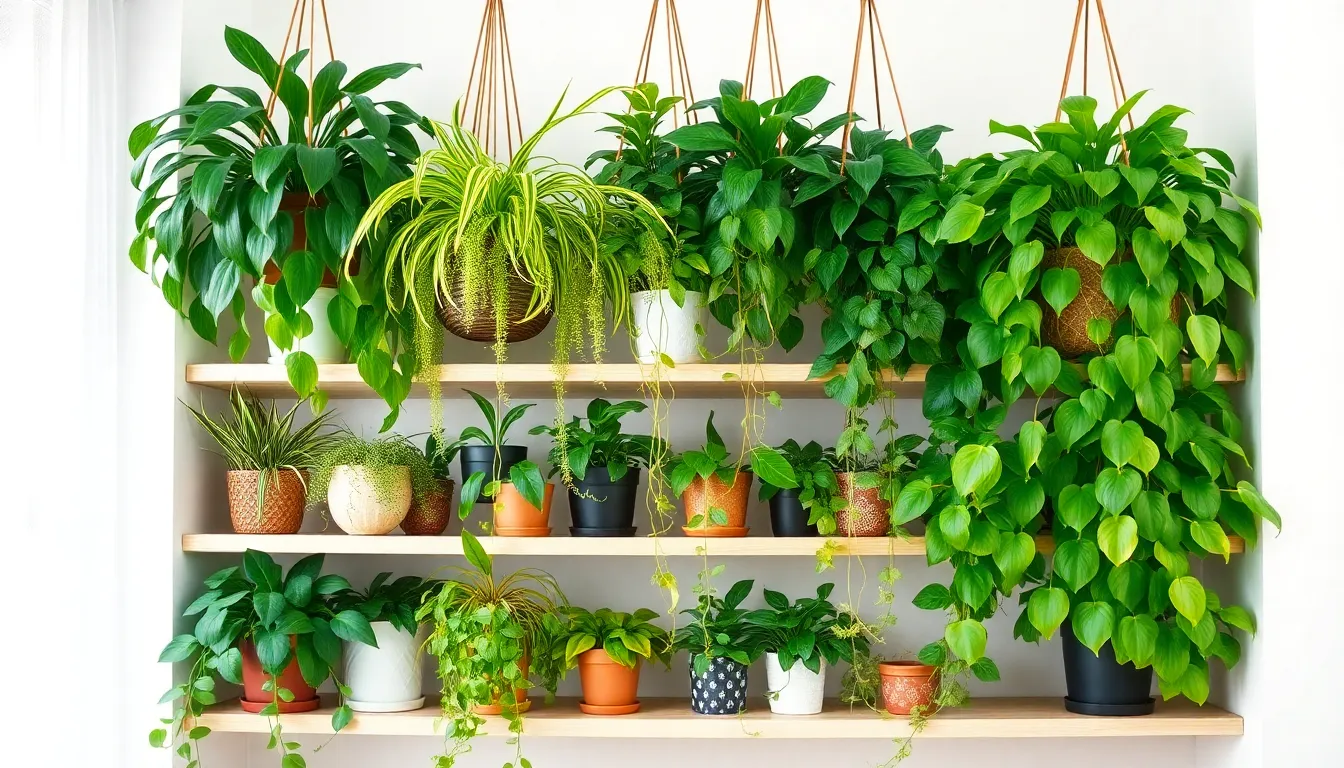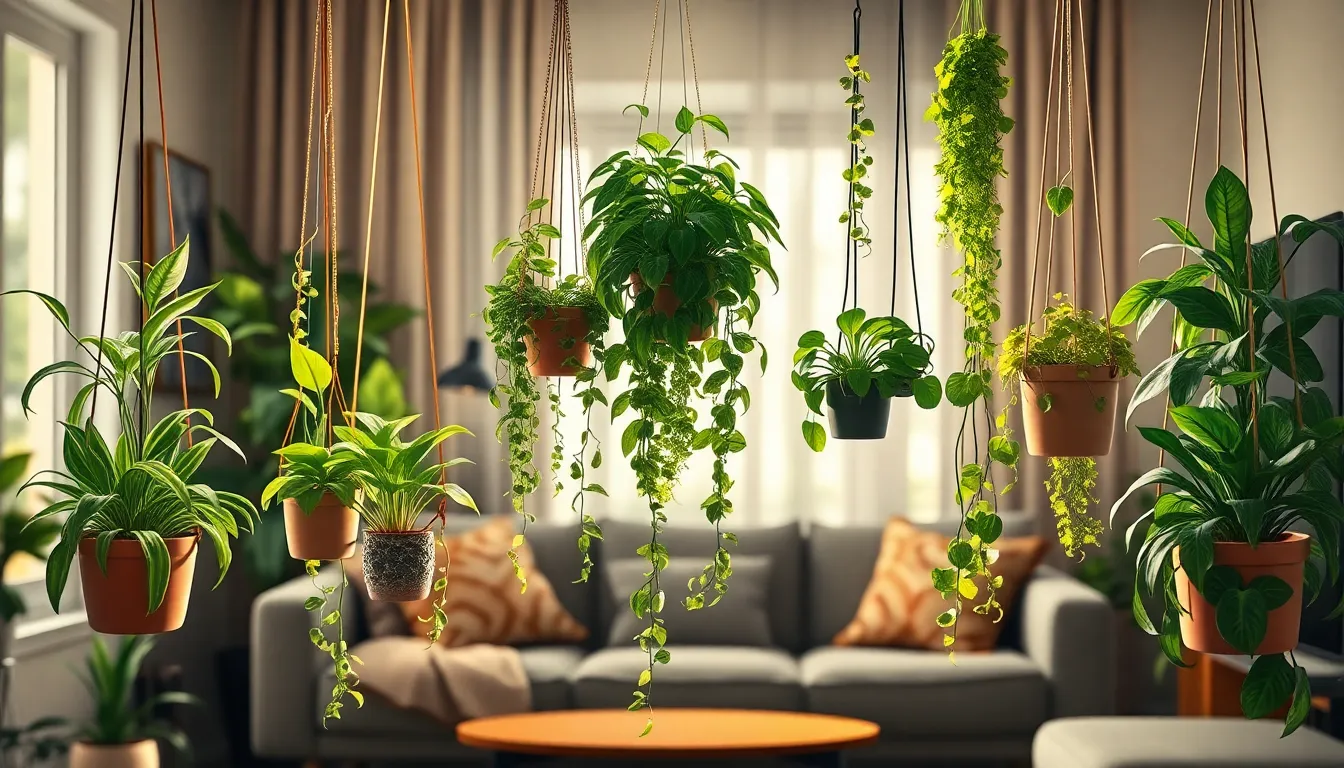Phone:
(701)814-6992
Physical address:
6296 Donnelly Plaza
Ratkeville, Bahamas.

Imagine transforming your dimly lit corners into lush green havens without needing a sun-soaked balcony or a degree in botany. Low light indoor hanging plants are the unsung heroes of home decor, effortlessly adding charm and vibrancy to spaces that might otherwise feel a bit gloomy. These leafy companions thrive in the shadows, proving that even the most light-challenged areas can bloom with life.
Low light indoor hanging plants offer numerous advantages, enhancing the ambiance of spaces with limited sunlight. They serve as both functional and decorative additions to any environment.
Low light indoor hanging plants contribute to air purification. They absorb carbon dioxide and release oxygen, improving indoor air quality. Certain varieties like pothos and spider plants effectively filter harmful toxins. Studies indicate these plants can remove pollutants such as formaldehyde and benzene. Indoor air can contain up to five times more pollutants than outdoor air, making these plants essential for health. Additionally, by promoting respiratory health, they create a fresher environment.
Low light indoor hanging plants enhance aesthetic appeal in various settings. They introduce visual interest and bring life to dull spaces, transforming them into vibrant areas. Attractive in design, these plants complement various decor styles. Options like philodendrons and ferns provide lush greenery, enriching the overall atmosphere. Hanging them in strategic locations draws the eye upward and maximizes available space. Overall, their presence fosters a calming ambiance, encouraging relaxation and creativity.


Low light indoor hanging plants add beauty and liveliness to any space. They thrive without direct sunlight, making them ideal for dimly lit areas.
Spider plants thrive in low light environments, making them popular indoor choices. With long, arching leaves, they create an attractive cascading effect. These plants produce baby “spiders” that can easily propagate. Additionally, spider plants excel in air purification by filtering toxins, including formaldehyde and xylene. Water them when the soil is dry to the touch for optimal health.
Pothos are resilient plants that adapt well to various lighting conditions. Their heart-shaped leaves come in vibrant shades of green and variegated patterns. Notably, pothos assist in cleaning indoor air, eliminating harmful substances like benzene and formaldehyde. They require minimal care, thriving in indirect light and tolerating occasional neglect. Allow the top inch of soil to dry before watering.
Philodendrons are versatile and easy to care for, making them great choices for low-light spaces. With their diverse leaf shapes and sizes, they fit well in any decor. This plant type absorbs indoor toxins and releases oxygen, promoting better air quality. Philodendrons prefer damp but not soggy soil, so it’s wise to check moisture levels regularly. Hanging them in a decorative pot enhances their visual appeal while allowing the leaves to gracefully drape down.
Caring for low light indoor hanging plants requires attention to a few key factors. Proper watering and fertilizing ensure plants thrive in dim conditions.
Watering requires a careful balance. Plants like pothos and spider plants prefer their soil to dry out slightly between waterings. Overwatering can lead to root rot, so checking soil moisture is essential. A finger test helps; inserting a finger into the soil up to the second knuckle provides a good indication of moisture content. If the top inch feels dry, it’s time to water. Adjusting watering frequency seasonally caters to changing light conditions and indoor humidity. During winter months, reduced growth means less frequent watering is necessary.
Fertilizing supports healthy growth in low light. Using a diluted, balanced liquid fertilizer every four to six weeks during the growing season boosts nutrient availability. Selecting a formula suited for houseplants enhances effectiveness. Avoid fertilizing in winter, as plants typically enter a dormant phase. Observing plants for signs of nutrient deficiency, such as yellowing leaves, guides fertilization decisions. Adjusting the feeding routine based on plant response can improve overall health and vibrancy.
Low light indoor hanging plants add a refreshing touch to any space. These plants thrive in dimly lit areas, enhancing the decor while improving air quality.
Selecting the perfect spot for hanging plants significantly impacts their growth. Locations near windows that filter indirect sunlight work well. Hanging them in kitchens or bathrooms enhances humidity levels that many low-light plants appreciate. High ceilings offer excellent opportunities for cascading plants, creating visual charm. Consider areas where plants can be easily observed to appreciate their beauty fully. Ensure accessibility for maintenance. Plants like pothos and spider plants thrive in various locations while adding liveliness.
Combining low light plants with other decor elements enhances visual interest. Use macrame hangers for a bohemian vibe, blending seamlessly with contemporary or rustic styles. Grouping plants at different heights creates dynamic displays. Mixing with decorative shelves, wall art, or mirrors allows for a layered aesthetic. Consider contrasting plant textures and colors to stimulate the senses. Displaying plants alongside books or candles promotes a cozy atmosphere. Utilizing planters with unique designs can further elevate the overall decor.
Low light indoor hanging plants offer a unique solution for brightening up dim spaces while enhancing overall decor. Their air-purifying qualities contribute to a healthier living environment, making them not just decorative elements but essential companions in any home. With a variety of options like pothos and spider plants, anyone can easily incorporate these greens into their daily life.
By following simple care tips and choosing the right locations, these plants can thrive and bring a touch of nature indoors. Embracing low light hanging plants is a smart way to create a calming atmosphere that inspires relaxation and creativity.